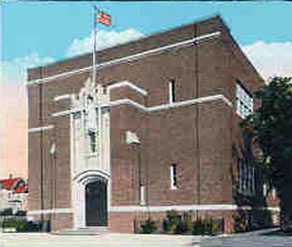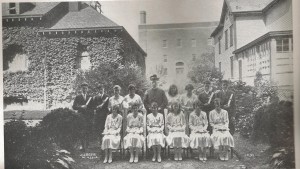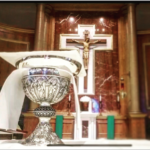By October, 1923, a parish census showed 140 families where both spouses were Catholic, and 260 families where only one spouse was Catholic. There were then 859 Catholics in the parish. A Sunday School held at the time averaged 135 youngsters in attendance. Fifty were baptized that year; 26 made Holy Communion; thirteen couples were married; and there were 16 deaths.
The “diamond-in-the-rough” who followed Father Sloane as pastor is still remembered by some in the community: Reverend Patrick J. Ford (1926-1937). Irish-born, with a tough exterior, he was the sort of pastor who visited his flock, family by family. Carrying forward Father Sloane’s dream, the school became his great effort, and it was brought to a reality at a cost of a quarter-million dollars. It opened in September, 1928, with an initial enrollment of 150 pupils, and the Sisters of Mercy of Dallas, Pennsylvania were enlisted to teach.
When the Great Depression hit the country, it seriously affected St. Boniface Martyr Parish. Few could meet pledges made in good faith, and the church was burdened with debt. Father Ford, in 1932, organized a “conference” of the St. Vincent de Paul Society as one bulwark against personal need suffered by the parishioners and others in Sea Cliff during those stark days. To make matters worse, in 1936, an arsonist set fire to the church building on three occasions, causing heavy damage and adding to the financial debt of the parish.
When Father Ford was moved to St. Sylvester’s in Brooklyn, he was succeeded by Reverend Charles B. Garvey (1937-46), a native of Cutchogue who was one of the first vocations from Suffolk County. During his pastorate, the Confraternity of Christian Doctrine (CCD) was organized, the Confraternity of the Rosary was begun, and the Carmelite Third Order set up a chapter here.
During W.W.II parishioners knitted scarves, held blood-banks, rolled bandages, sat fire-watches, and entertained “the Boys” from Mitchell Field and Roslyn Air Base. They whispered about the strange boats quartered at Fyfe’s Shipyard in Glenwood Landing that were tested up and down the harbor (which they later learned were the “PT Boats” of Pacific fame). They wrote a lot of V-Mail letters and also held special prayer services for a victorious D-Day. As a matter of fact, they did a lot of praying! During the war, more than 400 men and women of St. Boniface served in the armed forces and of these, 15 made the supreme sacrifice of their lives.
During the era of post-world war prosperity, many Catholic families moved out to the suburbs and into the parish. Despite the return to better times, many still felt the pinch of the long depression. To aid them in adjusting financially, while helping them avoid the high interest rates of the loan companies, a cooperative credit union was established among the parishioners. Small loans at very low interest rates were of untold value.
Father Garvey died as pastor in 1946, and was succeeded within a month by the Reverend William J. Gately. Under Father Gately’s leadership, the parish debt was paid off, and the church, school, convent and rectory were repaired and redecorated.
In May, 1947, a census revealed that the parish had grown to 1,198 families representing 3,645 individuals. During Father Gately’s stay, the parish celebrated its Golden Jubilee in 1948, with a Solemn Mass of Thanksgiving, with the Most Reverend Thomas E. Molloy, Bishop of Brooklyn, presiding. Father Gately was instrumental in establishing a Mothers’ Club as a support for the parochial school.
In 1952, Reverend Thomas W. Smiddy succeeded Father Gately. After a year of dedicated pastoral work Father Smiddy, in 1953, was transferred to the Chancery Office in Brooklyn where he was eventually elevated to Papal Chamberlain as a Very Reverend Monsignor. In exchange, the man who held that post in Brooklyn, Very Reverend Monsignor Vincent J. Baldwin, came to St. Boniface. He was aided in his adjustment to the life of pastor by Fathers O’Mara and Canning, who had long served in the parish. Three years later, Monsignor Baldwin left for St. Aloysius in Great Neck, and was succeeded by the Reverend John J. Fee.
Since three successive pastors, Fathers Gately, Smiddy and Baldwin, had each won high office in the Church after leaving St. Boniface, it was said at the time that a priest apparently “is never simply transferred from St. Boniface — he’s promoted!”
About a year after Father Fee’s arrival, an important change occurred. The Brooklyn Diocese had, from 1853, extended control over the entire length of Long Island. In May 1957, Nassau and Suffolk counties were separated from the old order and designated as a new diocese with its seat at Rockville Centre. The Most Reverend Walter P. Kellenberg became the new Bishop. At this time, Father Fee’s devotion to Mary was recognized and he was appointed director of the Legion of Mary for the new diocese, a post which he held until his death.









